by Mike –
The Lamborghini Miura always gets car lovers excited and the recent article on My Car Quest about the Miura raising the question again about the origin of the beautiful body design resulted in this message from my friend Flavio Campetti in Italy.
Text and model photos by by Flavio Campetti
Recently I attended a very interesting conference about Carrozzeria Touring Superleggera held in the city of Meda, near Milan, this past March 2014. Present were members of the Bianchi Anderloni family, including Eng. Giovanni Bianchi Anderloni, which were the founders of Touring in the 1920s.
It was a very nice conference with details of the whole history of Touring, and among other subjects, there was time to talk about the design study for Lamborghini for a project of a mid-engined GT that became the Miura.
I was very impressed when they said that they started the work on the Miura for Lamborghini. In fact the early sketch/drawings of the Miura were done in Touring. In that period they had big problems (also related with a partnership with the British group Rootes that forced Touring to make big investments that never paid off) that brought the Company to close on 31 December 1966. All of this caused the end of their involvement in the Miura project.
Here are photos I shot of the Miura model made by Touring Superleggera. You can evaluate for yourself if you think there’s a link between the final design of the Miura and the Touring Miura. Naturally there may be different opinions about this, but somebody says that maybe the work of Touring was useful for defining the final shape of the Miura.
Touring was the coachbuilder for the early Lamborghini models (the Lamborghini 350 GT and 400 GT which used the famous Superleggera body) so Touring management was in very close contact with Ferruccio Lamborghini at that time.
I think the pictures show something special!
That’s all I know.
~~~
The design history of the Lamborghini Miura is more cloudy that ever.
What do you think? Let us know in the Comments.
Sell your classic car on My Car Quest – click here.
Flavio Campetti was born in the Bresso/Milan area and is a classic car lover especially of the Iso marque. He wrote an excellent book about Iso, “Da Iso a ISORIVOLTA, Il fascino di un marchio”.
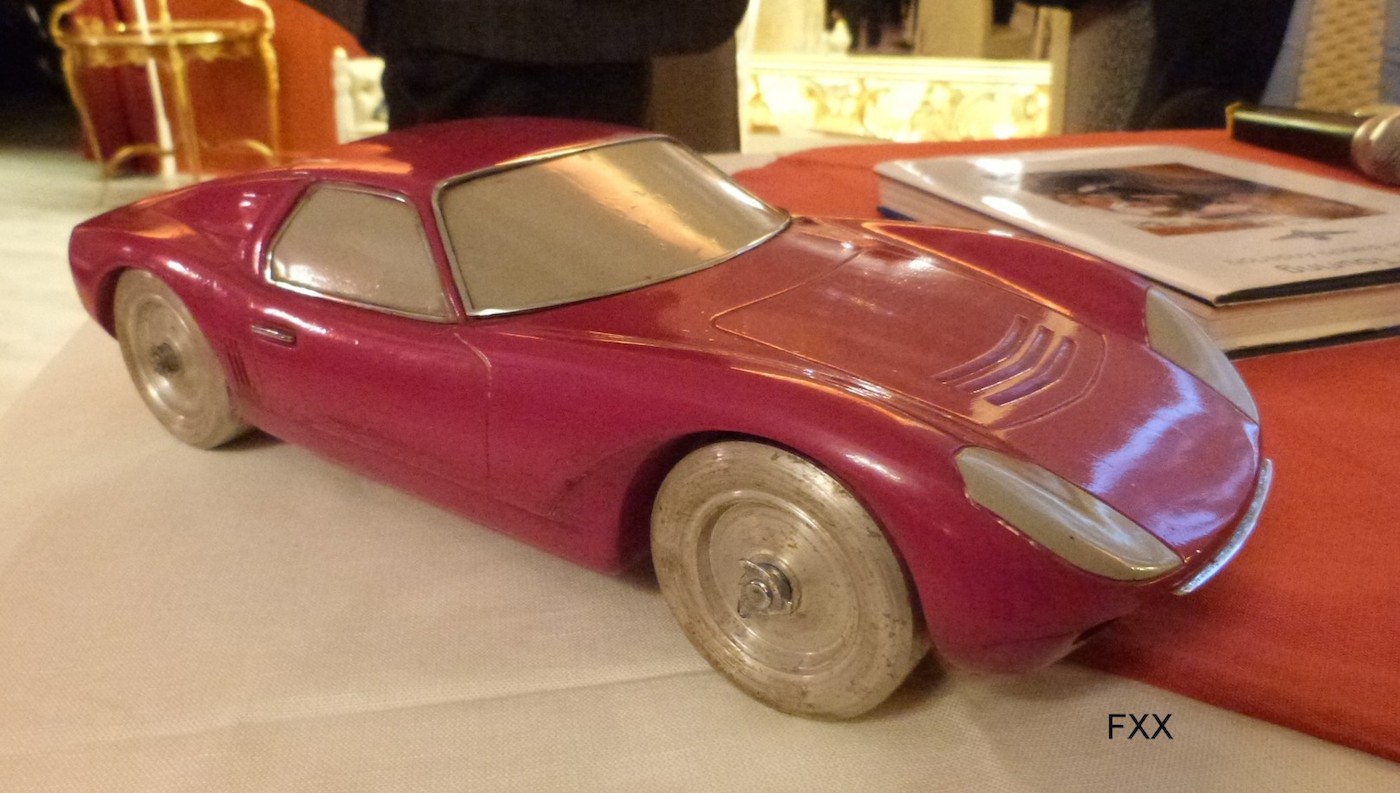
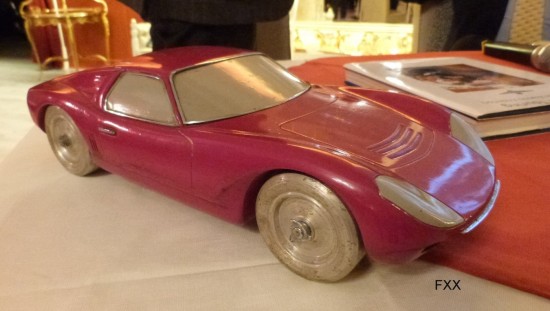
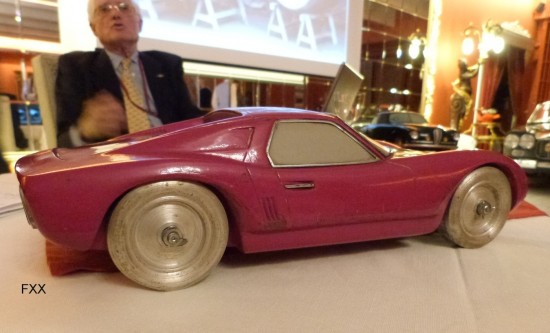
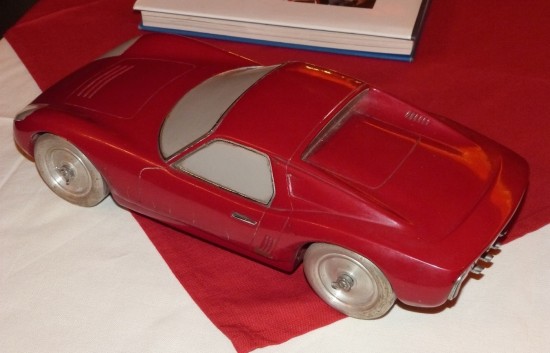
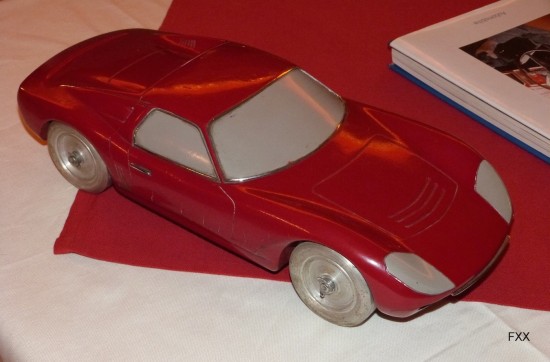
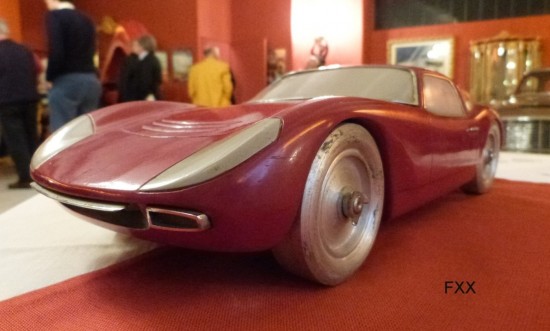
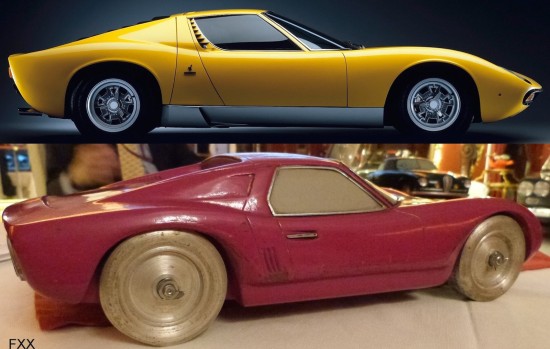
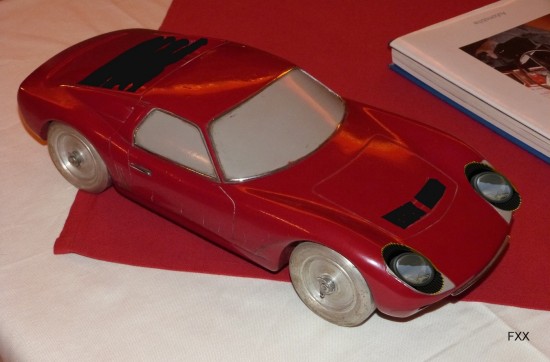
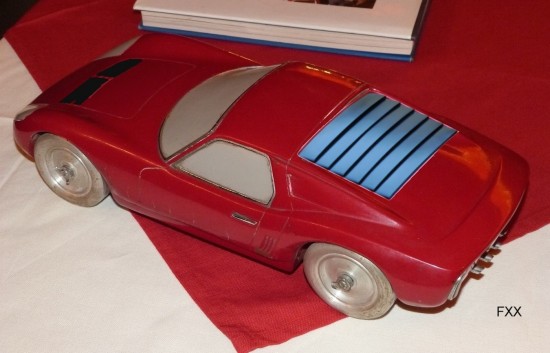
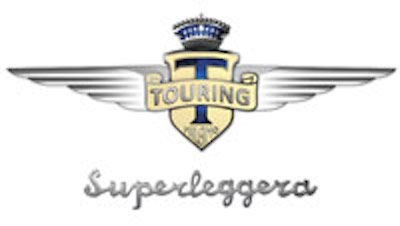



When looking at the model in the pictures, I did not see the Miura as much as I saw the Lamborghini one-off Monza. Why not try doing a silhouette shot of the Monza along with the Miura and see what your readers think. You might also check the year of manufacture of the Monza.
There is obviously some similarities between this design and the final Miura. Designers at that time were using similar body ideas and shaping methods derived primarily from the developments in racing. Race cars were (in the 1950’s and 1960’s wonderful inspiration for road cars. They were immediately on the scene and for any enthusiast, the photos would inspire quick reactions in the studios, resulting in competitively similar ideas in models and show cars.
The Miura was developed concurrently through the work of Tourning as Campetti accurately details, but I had always thought it was only inspirational in a general context and never came to a full sized fruition. Anderloni told me many years ago that during the last few years of Touring, the work they did was near desperation to earn any job to keep the business going through some very difficult times. One of those speculative jobs was with Lamborghini using the newly developed mid-engine chassis. I was not aware the project had gone to the point of a concept model, nor this far evolved.
But if you look also at the Scaglione/Allemano ATS, I think you will find significant similarities that indicate Scaglione had some hand in the general design ideas as shown in the Miura as well. Remember Scaglione was employed by Bertone as Chief of Design in the years before Giugiaro, going on to pen many more cars after.
/Users/chris/Desktop/1963-ats-2500-gt-side.jpg
The bottom line on the Muira is you will find many cars of this era with great similarities (though admittedly this Touring model shows some important lineage). Gandini would make a name for himself with a body of work that shows highly angular sculptural descriptions and (his own admission) less interest in the “look” of a car and more the technical fusion of forms implied by the mechanical features. He and Giugiaro did not get along. Giugiaro had already highly influenced the start of the Miura with his (then) sinewy sculptural style. One need only look at the previous design history of Giugiaro to know the Miura emerged as part of his lineage and Gandini perfected that ideal in his newly appointed role.
In the end, the Miura is a car that was designed and built by many people, all passionate to do something different and beautiful. Simply being in the presence of this car one sees Gandini, Guigiaro, Bertone, and Lamborghini within the car. Like the Beatles, it was not any single musician that made their music so impactful, it was the energy of ALL of them doing it on stage at the right time. And we get to enjoy that visual music every time we see a Miura!!
What a very succinct and elegant description of the car.
A fusion from many, all a part of the passion.
Perfect.
I wonder how much passion there is in design studios these days.
Thanks TonyO. There is the same passion in design for cars today and much of it is in the major studios. But it is harder and harder to devise clever and radically different forms these days due to many new restrictions. That does not limit the creative drive, as young people are constantly pushing the horizons – that’s what they are designed to do best even though we are challenged by them as teen-agers 🙂
New tools and digital advances have changed much of the profession from hand sculpting to virtual generation, but the love, the drive, the eagerness to make something both powerful and beautiful is very much alive in worldwide automotive design studios.
How interesting to see all the different hands that were involved in the Miura. When I look at cars I often strip off all the trim and industrial design pieces to see the true form, iMO this is very similar to the Miura much more so than the Giugiaro design.
I wonder if Bertone was able to view the Touring design before he started his work with Giugiaro?
Thanks to Flavio and Mike G for this interesting bit of Miura History.
Gandini, a beginner, was not the only person in the room.
This model is a crude representation of a mid-engine car, actually any transverse mid-engine car. The proportions are there, similar to the final Miura but the design and form language is very unsophisticated. Still it could have been an early expression of the later car on the Lamborghini chassis. Some details are similar but it is hard to believe that the car started at Bertone would end up so close to the model unless there was a genuine influence. That could be possible as the mid-engine platform over which the design was done is the same..
The model is in several different stages with changes and obviously late Photoshop editions like the Corvair Monza GT backlite slats, probably added later in the Miura program, possibly by Bertone. The body side section, very much like the previous Iso Giugiaro RWD coupe is no accident as it could mean the desire by Lamborghini for the use of common door hinges, locks and glass drop mechanism. The high rocker, like the coupe, is also another sign of either trying to create a family design identity or other engineering criteria. Also the very low hood, which supposedly was inspired by Gandini early in the program at Bertone. This does not make sense unless the Lamborghini engineers did not respond to Flavio’s desires.
The profile of the two fender shapes with the section between them is very much like the final car and the previously mentioned Giugiaro RWD coupe. The fender peak flowing into the front end is also very much like the Monza GT.
The model also shows several attempts to lower drag, like the rear of the front wheel openings and windshield-side. pillar, glass relationship that is very different than the final design. Also there is a depression on the rear deck that could be interpreted as a forward spoiler. This would be fruitless and only a design shape as no one would know the ideal height and length of the deck-lid aerodynamically unless it was aero tested.
This model, if unchanged from the time it was presented to Lamborghini, is predictive of how the car was finalized.
What is sorely lacking here is the wonderful surface form language epitomized in Giugiaro’s work for years at Stile Bertone.
Here is a crude timeline based on what has been known, this presentation and the new Gandini book statements about the car.
1.
The Touring model, as it is, is predictive of the final design.
2.
Lamborghini expresses admiration for the Alfa Romeo Cangaro.
3,
Giugiaro makes some sketches with Cangaro design cues.
4.
Bertone then meets Lamborghini at the Turin Show and sees the chassis.
5.
Bertone is chosen to create a design for the Geneva show four months later, a very stiff assignment.
6.
It is possible that Bertone saw this model which could have given him a huge head start, which Bertone would have been happy to have. Lamborghini could also have had drawings of it. Bertone would immediately see the opportunity availabe to him with his in house staff.
The Bertone staff, designers, engineers and sculptors were operating for years under Giugiaros aesthetic direction. They did not, actually could not stop just because he left and Gandini arrived. The form language of the Miura is very sophisticated and sensual as well as emotional in it’s execution. There is no doubt that Giorgetto Giugiaro had an influence. Anyone who will not admit it is in denial.
DICK RUZZIN
Hey Dick, glad to hear from a professional designer. My question is; I have seen some very crude sketches of the Miura, front 3/4 in black and white,
(third drawing down on this website
http://www.lamborghinimiura.com/PAGE1/DESIGN_MIURA1.HTM
and wonder how is it possible that such a good looking car in person looked so bad in the sketches. Maybe Gandini could work well in three dimensions but was not known for beautiful sketches? Maybe we are spoiled by GIugiaro where his sketches look (almost) as good as the finished car? Do you think if the final form looks good, that the quality of the sketch is really unimportant later? Or is it just a poor sketching style?